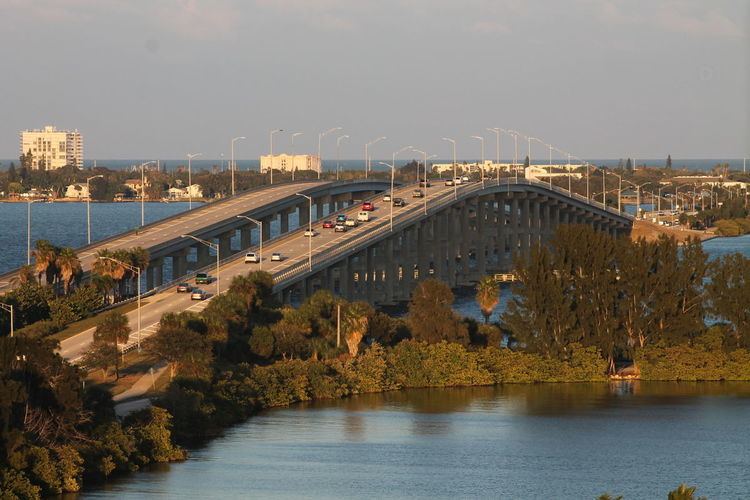Opened 1979 Longest span 790 m | Length 2,000 m Clearance below 15 m | |
 | ||
Carries 2 general purpose lanes of US 192(each bridge) ID number 700174 - Westbound700181 - Eastbound Similar Eau Gallie Causeway, Indian River Lagoon, Wabasso Bridge, Trammell Bridge, Sebastian Inlet Bridge | ||
Full moon crossing of melbourne causeway to indialantic
The Melbourne Causeway is located entirely within Brevard County, Florida in the United States. It is composed of three bridges and connects the municipalities of Melbourne and Indialantic across the Indian River Lagoon in Brevard County. The causeway is part of U.S. 192 (also known as SR 500), whose eastern terminus is located approximately 2 miles (3.2 km) east of the bridge, at SR A1A. East of the bridge, the road is known locally as Fifth Avenue. On the western side, the road continues through downtown Melbourne as Strawbridge Avenue. Each July 4 the bridge is closed for a fireworks show.
Contents
- Full moon crossing of melbourne causeway to indialantic
- E49 surprise manatee encounter at melbourne causeway
- First Bridge
- Second Bridge
- Third Bridge
- Ernest Kouwen Hoven Memorial Bridge
- Relief Bridges
- Kiwanis Park at Geiger Point
- References
There are two bridges in Melbourne, the Melbourne Causeway and the Eau Gallie Causeway (SR 518) With the latter being named for the old city of Eau Gallie, which merged with Melbourne in 1969.
E49 surprise manatee encounter at melbourne causeway
First Bridge
Ernest Kouwen-Hoven began construction of the second bridge across the Indian River in 1919. The first bridge was completed 2 years earlier near Cocoa, Florida. By May 1921 the bridge was complete and unofficially opened as a toll bridge. It was 9,706 feet ( 2958 meters) or nearly 2 miles (3.2 km) long (3 kilometers). Approximately 1/3 of the way from Melbourne there was a 134-foot (41 m) long hand operated draw. On September 18, 1921 it officially opened. A Mr. J. E. Campbell was the first to drive across the bridge. During construction three sawmills were built by Ernest Kouwen-Hoven. They did not all exist at the same time. The first one was in Melbourne Village, the second was on the Nevin Property on Merritt Island, and the third was 5 miles (8.0 km) west of Grant.
Second Bridge
In 1941, construction began on the second bridge between Melbourne and Indialantic. This bridge was a low-rise swing draw bridge. On August 1, 1947 Mrs. Ernest Kouwen-Hoven cut the ribbon and the same J. E. Campbell that crossed the first bridge, was the first to cross this bridge.
Third Bridge
The third bridge contains two twin spans that are 2,592.5 feet (790.2 m) long. According to the Melbourne Centennial Book the official start of construction was February 2, 1976, and the bridge was expected to be complete by fall of 1977. It appears to have been delayed with the westbound span being constructed in 1977 and ending 2 years later. From bridge id numbers, it appears that the western relief bridges were also constructed during this time. Construction of the eastbound span did not begin until 1981 and finished in 1984.
Ernest Kouwen-Hoven Memorial Bridge
The Ernest Kouwen-Hoven Memorial Bridge is the official name of the high-rise span, officially dedicated by the State of Florida Legislature on 28 May 1978. This name is not used locally, and only appears in official government documents.
Relief Bridges
These bridges are unremarkable, and have no appreciable change in grade. The easternmost relief bridge is commonly used by local fishermen.
Kiwanis Park at Geiger Point
At the base of the causeway on the western side is the Kiwanis Park at Geiger Point, a 7-acre community park managed by the Brevard County Parks & Recreation.
